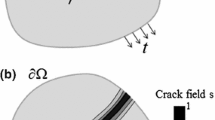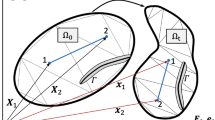Abstract
In the recent decade, there has been a growing interest in using the phase-field approach to model fracture processes in various materials. Conventional phase-field implementations can simulate fracture processes using bi-linear finite element (LFE) shape functions but at the expense of a very fine mesh. In contrast, exponential finite element (EFE) shape functions can predict sharp gradients in solution variables with coarse meshes due to their exponential nature. A potential advantage lies in reducing the number of elements in the problem without losing accuracy in the solution. However, EFE shape functions do not yield a good approximation unless they are oriented relative to the expected crack propagation path. This study uses an approximate analysis using LFE shape functions to orient the EFE shape functions before the computations. Computational advantages are reported in terms of accuracy in predicted load responses and the computational times incurred.














Similar content being viewed by others

References
ABAQUS/Standard User’s Manual, Version 6.9 (2009) Dassault Systèmes Simulia Corp
Ambati M, Gerasimov T, Lorenzis LD (2014) A review on phase-field models of brittle fracture and a new fast hybrid formulation. Comput Mech 55(2):383
Ambati M, Gerasimov T, Lorenzis LD (2015) Phase-field modeling of ductile fracture. Comput Mech 55(5):1017
Amor H, Marigo JJ, Maurini C (2009) Regularized formulation of the variational brittle fracture with unilateral contact: numerical experiments. J Mech Phys Solids 57(8):1209
Areias P, Msekh M, Rabczuk T (2016) Damage and fracture algorithm using the screened Poisson equation and local remeshing. Eng Fract Mech 158:116
Belytschko T, Lu Y, Gu L (1995) Crack propagation by element-free Galerkin methods. Eng Fract Mech 51(2):295
Borden MJ, Verhoosel CV, Scott MA, Hughes TJ, Landis CM (2012) A phase-field description of dynamic brittle fracture. Comput Methods Appl Mech Eng 217–220:77
Bourdin B, Francfort GA, Marigo JJ (2000) Numerical experiments in revisited brittle fracture. J Mech Phys Solids 48:797
Chen WX, Wu JY (2022) Phase-field cohesive zone modeling of multi-physical fracture in solids and the open-source implementation in comsol multiphysics. Theoret Appl Fract Mech 117:103153
Francfort GA, Marigo JJ (1998) Revisiting brittle fracture as an energy minimization problem. J Mech Phys Solids 46(8):1319
Fries TP, Belytschko T (2010) The extended/generalized finite element method: an overview of the method and its applications. Int J Numer Methods Eng 84(3):253
Gerasimov T, De Lorenzis L (2016) A line search assisted monolithic approach for phase-field computing of brittle fracture. Comput Methods Appl Mech Eng 312:276
Griffith AA, Taylor GI (1921) The phenomena of rupture and flow in solids. Philos Trans R Soc Lond 221(582–593):163
Heister T, Wheeler MF, Wick T (2015) A primal-dual active set method and predictor-corrector mesh adaptivity for computing fracture propagation using a phase-field approach. Comput Methods Appl Mech Eng 290:466
Hirshikesh C, Jansari K, Kannan R, Annabattula S (2019) Adaptive phase field method for quasi-static brittle fracture using a recovery based error indicator and quadtree decomposition. Eng Fract Mech 220:106599
Hofacker M, Miehe C (2012) Continuum phase field modeling of dynamic fracture: variational principles and staggered FE implementation. Int J Fract 178(1–2):113
Hofacker M, Miehe C (2013) A phase field model of dynamic fracture: robust field updates for the analysis of complex crack patterns. Int J Numer Methods Eng 93(3):276
Irwin GR (1957) Analysis of stresses and strains near the end of a crack traversing a plate. J Appl Mech 24(3):361
Kristensen PK, Martínez-Pañeda E (2020) Phase field fracture modelling using quasi-Newton methods and a new adaptive step scheme. Theoret Appl Fract Mech 107:102446
Kuhn C, Müller R (2011a) A new finite element technique for a phase field model of brittle fracture. J Theor Appl Mech 49:1115
Kuhn C, Müller R (2011b) Exponential finite element shape functions for a phase field model of brittle fracture. Computational plasticity XI—fundamentals and applications, COMPLAS XI. pp 478–489
Liu Y, Li Y, Xie W (2017) Modeling of multiple crack propagation in 2-D elastic solids by the fast multipole boundary element method. Eng Fract Mech 172:1–16
Mandal TK, Nguyen VP, Wu JY (2019) Length scale and mesh bias sensitivity of phase-field models for brittle and cohesive fracture. Eng Fract Mech 217:106532
Mandal TK, Nguyen VP, Wu JY, Nguyen-Thanh C, de Vaucorbeil A (2021) Fracture of thermo-elastic solids: phase-field modeling and new results with an efficient monolithic solver. Comput Methods Appl Mech Eng 376:113648
Miehe C, Hofacker M, Welschinger F (2010a) A phase field model for rate-independent crack propagation: robust algorithmic implementation based on operator splits. Comput Methods Appl Mech Eng 199(45):2765
Miehe C, Welschinger F, Hofacker M (2010b) Thermodynamically consistent phase-field models of fracture: variational principles and multi-field FE implementations. Int J Numer Methods Eng 83(10):1273
Miehe C, Schänzel LM, Ulmer H (2015) Phase field modeling of fracture in multi-physics problems. Part I. Balance of crack surface and failure criteria for brittle crack propagation in thermo-elastic solids. Comput Methods Appl Mech Eng 294:449
Miehe C, Aldakheel F, Raina A (2016) Phase field modeling of ductile fracture at finite strains: a variational gradient-extended plasticity-damage theory. Int J Plast 84:1–32
Moës N, Dolbow J, Belytschko T (1999) A finite element method for crack growth without remeshing. Int J Numer Methods Eng 46(1):131
Olesch D, Kuhn C, Schlüter A, Müller R (2021) Adaptive numerical integration of exponential finite elements for a phase field fracture model. Comput Mech 67:811–821
Peerlings R, Borst R, Brekelmans W, Vree J, Spee I (1996) Some observations on localization in non-local and gradient damage models. Eur J Mech Solids A 15(6):937
Pham KH, Ravi-Chandar K, Landis CM (2017) Experimental validation of a phase-field model for fracture. Int J Fract 205(1):83
Tian F, Tang X, Xu T, Yang J, Li L (2019) A hybrid adaptive finite element phase-field method for quasi-static and dynamic brittle fracture. Int J Numer Methods Eng 120(9):1108
Verhoosel C, Borst R (2013) A phase-field model for cohesive fracture. Int J Numer Methods Eng 96:43
Wick T (2016) Goal functional evaluations for phase-field fracture using PU-based DWR mesh adaptivity. Comput Mech 57(6):1017
Wilson ZA, Landis CM (2016) Phase-field modeling of hydraulic fracture. J Mech Phys Solids 96:264
Winkler B (2001) Traglastuntersuchungen von unbewehrten und bewehrten Betonstrukturen auf der Grundlage eines objektiven Werkstoffgesetzes für Beton
Wu JY, Nguyen VP (2018) A length scale insensitive phase-field damage model for brittle fracture. J Mech Phys Solids 119:20
Wu JY, Huang Y, Nguyen VP (2020a) On the BFGS monolithic algorithm for the unified phase field damage theory. Comput Methods Appl Mech Eng 360:112704
Wu JY, Nguyen VP, Nguyen CT, Sutula D, Sinaie S, Bordas SP (2020b) Phase-field modeling of fracture. In: Hutchinson JW, Wu TY (eds) Advances in applied mechanics. Elsevier, Cambridge, pp 1–183
Author information
Authors and Affiliations
Corresponding author
Ethics declarations
Conflict of interest
The authors declare that they have no conflict of interest.
Additional information
Publisher's Note
Springer Nature remains neutral with regard to jurisdictional claims in published maps and institutional affiliations.
Rights and permissions
Springer Nature or its licensor (e.g. a society or other partner) holds exclusive rights to this article under a publishing agreement with the author(s) or other rightsholder(s); author self-archiving of the accepted manuscript version of this article is solely governed by the terms of such publishing agreement and applicable law.
About this article
Cite this article
Sidharth, P.C., Rao, B.N. Phase-field modeling of brittle fracture using automatically oriented exponential finite elements. Int J Fract 242, 169–189 (2023). https://doi.org/10.1007/s10704-023-00708-9
Received:
Accepted:
Published:
Issue Date:
DOI: https://doi.org/10.1007/s10704-023-00708-9



